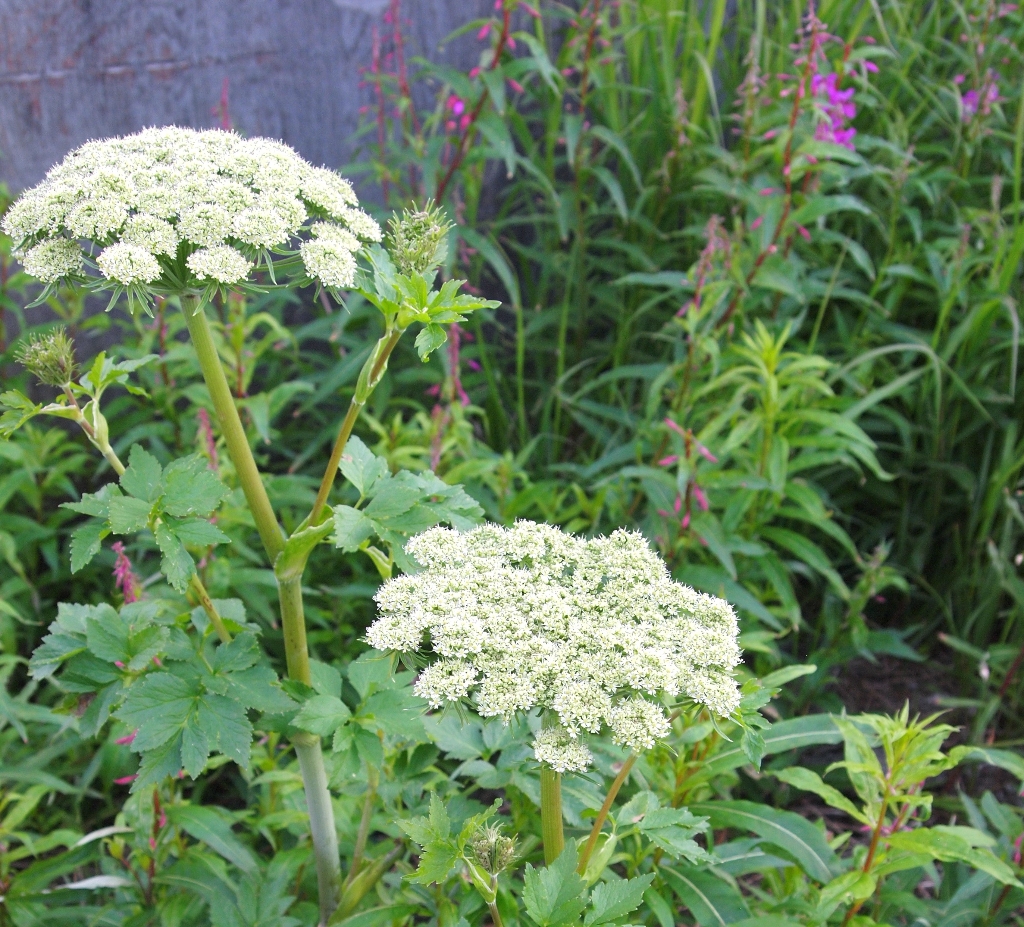
Angelica (Angelica lucida) is also called wild celery, wild parsnip or ikuusuk (with dialect variations: ikuusuuk/ikuusuich) in Iñupiaq.
The young shoots of this plant are edible, but the older the plant gets, the less edible it becomes. It is also extremely important to note that the root is toxic if ingested at any point. Only the stalks and leaves should be eaten.
Medicinally, Angelica has been used for hundreds of years, and around the world, not just in the Northwest Arctic. The root can be used outside the body to help for aches, pains, sores, cuts, and more. The best way to use the root is by cutting, mashing, and boiling it to create a poltice and then placing it directly on treatment area, even for deep pains.
Chewing on the leaves is said to cure a head cold and the many symptoms associated with it.
Native Siberians inhaled fumes of the roasted Angelica root for a seasickness remedy.
This plant should not be confused with the Poison Water Hemlock (Cicuta mackenzieana) which also grows in the region. There are many ways to tell these two plants apart. Wild celery smells strongly like celery. Its flowers are in a stiff, flat cluster with wide, flat leaves. Poision water hemlock on the other hand has loose flowers and thin leaves. It also has an obvious waxy look when compared to wild celery.
Sources:
The young shoots of this plant are edible, but the older the plant gets, the less edible it becomes. It is also extremely important to note that the root is toxic if ingested at any point. Only the stalks and leaves should be eaten.
Medicinally, Angelica has been used for hundreds of years, and around the world, not just in the Northwest Arctic. The root can be used outside the body to help for aches, pains, sores, cuts, and more. The best way to use the root is by cutting, mashing, and boiling it to create a poltice and then placing it directly on treatment area, even for deep pains.
Chewing on the leaves is said to cure a head cold and the many symptoms associated with it.
Native Siberians inhaled fumes of the roasted Angelica root for a seasickness remedy.
This plant should not be confused with the Poison Water Hemlock (Cicuta mackenzieana) which also grows in the region. There are many ways to tell these two plants apart. Wild celery smells strongly like celery. Its flowers are in a stiff, flat cluster with wide, flat leaves. Poision water hemlock on the other hand has loose flowers and thin leaves. It also has an obvious waxy look when compared to wild celery.
Sources:
- Jones, Anore. Plants That We Eat: Nauriat Nigiñaqtuat. Univ. of Alaska Press, 2010.
- Garibaldi, Ann. Medicinal Flora of the Alaska Natives: a Compilation of Knowledge... Alaska Natural Heritage Program, Environment and Natural Resources Institute, University of Alaska Anchorage, 1999.
- Schofield, Janice J. Discovering Wild Plants: Alaska, Western Canada, the Northwest. Alaska Northwest Books, 1995.
Is there something we missed for this itinerary?
Itineraries across USA

Acadia

Arches National Park

Badlands

Big Bend

Biscayne

Black Canyon Of The Gunnison

Bryce Canyon

Canyonlands

Capitol Reef

Carlsbad Caverns

Channel Islands

Congaree

Crater Lake

Cuyahoga Valley

Death Valley

Dry Tortugas

Everglades

Gateway Arch

Glacier

Grand Canyon

Grand Teton

Great Basin

Great Smoky Mountains

Guadalupe Mountains

Haleakalā

Hawaiʻi Volcanoes

Hot Springs

Indiana Dunes

Isle Royale

Joshua Tree

Kenai Fjords

Kobuk Valley

Lassen Volcanic

Mammoth Cave

Mesa Verde

Mount Rainier

North Cascades

Olympic

Petrified Forest

Pinnacles

Rocky Mountain

Saguaro

Shenandoah

Theodore Roosevelt

Virgin Islands

Voyageurs

White Sands

Wind Cave

Yellowstone

Yosemite

Zion